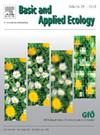用一种新的方法确定德国东北部稀有濒危凤兰Liparis loeselii的危险因素
IF 3.5
2区 环境科学与生态学
Q2 ECOLOGY
引用次数: 0
摘要
沼泽是中欧最受威胁的栖息地之一,有许多特殊的植物物种。其中一种是凤兰Liparis loeselii,它在大多数欧洲内陆沼泽中受到威胁并正在减少。然而,导致物种减少的风险因素却知之甚少。因此,我们研究了德国东北部17个现存种群遗址和11个灭绝种群遗址的植被结构、物种组成和非生物条件。研究人员采用了一种新的方法,将系统随机样地(评估常见的、平均的生境条件)与选择性放置样地(针对黄叶松的微生境)相结合,解决了物种的斑块性和稀有性带来的方法学挑战。与现有遗址相比,灭绝种群前遗址具有湿度较低、泥炭退化程度较高、养分有效性较高、苔藓和草本覆盖较低、硝化植物和普通草地物种丰富度较高、特殊物种较少的特点。平均生境条件与微生境之间也存在类似差异;后者植被高度较低,光有效度较高,裸土比例较高。本研究表明,研究区黄泥炭的主要危险因素是沼泽退化加剧,由于排水或干旱导致地下水位下降,上层泥炭层退化并释放养分。这使得物种组成向更高、更具竞争力的物种转变,增加了遮荫、凋落物覆盖、有限的开阔斑块和棕色苔藓,最终导致局部灭绝。因此,保持或恢复永久的高地下水位对保护黄沙草和一般的沼泽是至关重要的。我们的方法被证明是成功的,只有适度的样本量,可能有助于研究其他稀有物种。本文章由计算机程序翻译,如有差异,请以英文原文为准。
Identifying risk factors for the rare, endangered fen orchid Liparis loeselii in NE Germany with a fresh approach
Fen mires are one of the most threatened habitats in Central Europe and harbor numerous specialized plant species. One of these species is the fen orchid Liparis loeselii, which is threatened and declining in most European inland fens. However, the risk factors driving the species’ decline are poorly understood. We therefore studied vegetation structure, species composition, and abiotic conditions at 17 current sites with extant and 11 former sites with extinct populations in north-eastern Germany. The methodological challenges posed by the patchiness and rarity of the species were tackled with a fresh approach that combined systematically random plots (assessing common, average habitat conditions) with selectively placed plots (targeting L. loeselii microhabitats). Compared to current sites, former sites of extinct populations were characterized by lower moisture, higher peat degradation, higher nutrient availability, lower moss and herb cover, higher abundancies of nitrophytes and common grassland species, and less fen specialist species. Similar differences emerged between average habitat conditions and L. loeselii microhabitats; and the latter furthermore featured lower vegetation height, higher light availability, and higher proportions of bare soil. Our study indicates that the main risk factors for L. loeselii in our study region resulted from enhanced fen degradation, where lowered water tables due to drainage or drought degraded the upper peat layers and released nutrients. This changed the species composition toward taller, more competitive species which increased shading, litter cover, and limited open patches and brown mosses, ultimately leading to local extinctions. It is therefore crucial that permanently high water tables are maintained or restored to protect L. loeselii – and fen mires in general. Our approach proved successful with only moderate sample size and may facilitate investigating other rare species.
求助全文
通过发布文献求助,成功后即可免费获取论文全文。
去求助
来源期刊

Basic and Applied Ecology
环境科学-生态学
CiteScore
6.90
自引率
5.30%
发文量
103
审稿时长
10.6 weeks
期刊介绍:
Basic and Applied Ecology provides a forum in which significant advances and ideas can be rapidly communicated to a wide audience. Basic and Applied Ecology publishes original contributions, perspectives and reviews from all areas of basic and applied ecology. Ecologists from all countries are invited to publish ecological research of international interest in its pages. There is no bias with regard to taxon or geographical area.
 求助内容:
求助内容: 应助结果提醒方式:
应助结果提醒方式:


